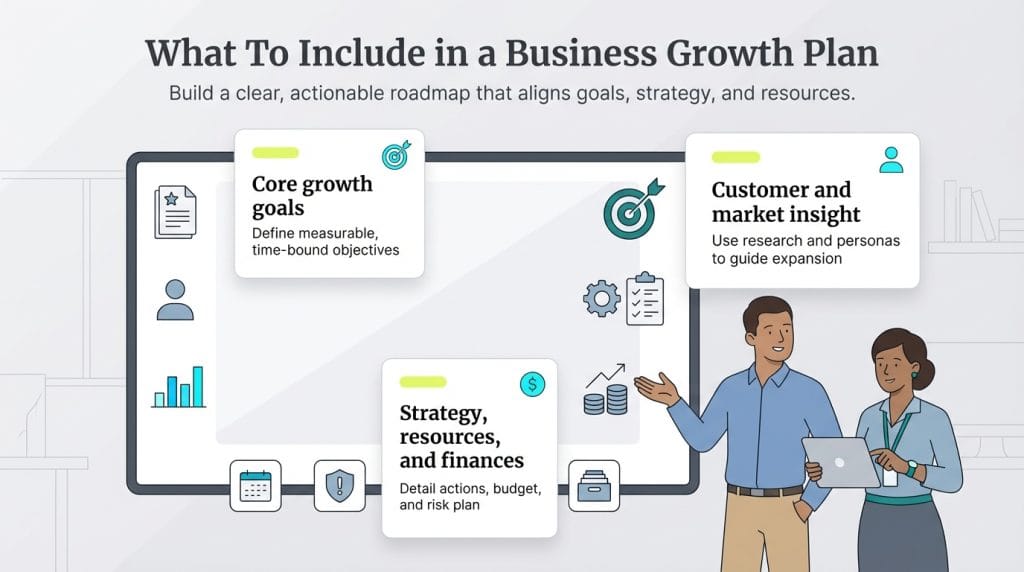Business.com aims to help business owners make informed decisions to support and grow their companies. We research and recommend products and services suitable for various business types, investing thousands of hours each year in this process.
As a business, we need to generate revenue to sustain our content. We have financial relationships with some companies we cover, earning commissions when readers purchase from our partners or share information about their needs. These relationships do not dictate our advice and recommendations. Our editorial team independently evaluates and recommends products and services based on their research and expertise. Learn more about our process and partners here.
Writing a Business Growth Plan
A strategically developed business growth plan can set your business on a path toward long-term profitability.

Table of Contents
When you run a business, it’s easy to get caught in the moment and focus only on the day in front of you. However, to be truly successful, you must look ahead and plan for growth. To do this, you should create a business growth plan; it should map out a set period of time and pinpoint how you’ll expand your company and increase revenue during that time. Business.com’s business growth plan guide details exactly what to include in your growth plan, along with actionable advice from business strategy experts.

What is a business growth plan?
A business growth plan outlines where a company sees itself at a particular point in the future — and how it plans to get there via specific expansions. Business owners and leaders need to apply a growth mindset to create plans for expansion and increased revenues to ensure their company will thrive long-term. Creating a useful business growth plan takes time, but keeping your growth efforts on track can pay off substantially.
“A business growth plan is a clear, step-by-step guide for how a company will grow,” Sachin Puri, chief growth officer (CGO) at web-hosting company Liquid Web, told business.com. “It shows where the business wants to go, how to get there and what’s needed to make it happen. Think of it as a map to success.”
Puri noted such plans are “especially important when a business is trying to grow fast, expand into a new market or face[s] big changes. It keeps you focused and gives you a clear path forward.”
What is the difference between a business growth plan and a business plan?
Though similarly named, a business growth plan is not the same as a business plan.
“A business growth plan vs. a generic business plan reflects an organization that is trying to grow faster than its market space or do something strategically interesting, different or important in that year, not just growing a little bit,” said Mariann McDonagh, president of McDonagh Growth Associates and operating partner at Edison Partners, a growth equity firm.
If a company is “looking to expand their ideal customer profile, moving into a tangential market, something that requires new effort, new strategy or new thinking,” then a business growth plan is in order, McDonagh said. In contrast, regular business plans are expected when first starting an enterprise.
What to include in a business growth plan

Business.com spoke with CGOs, chief strategy officers (CSOs), and other business professionals about developing and writing business growth plans. Based on their expertise, we recommend including the following elements in your growth plan.
Executive summary
Johannes Heinlein, CGO at the Project Management Institute (PMI), says a successful business growth plan should be clear and actionable so it can lead to a positive impact.
“It typically begins with an executive summary that explains why the plan was created, identifies key growth opportunities and outlines the desired outcomes,” Heinlein said.
Soren Godbersen, CGO at EquityMultiple, said you should aim to give a “high-level overview of goals and strategies.” There will be plenty of opportunities to go into detail in the subsequent sections. In this way, the executive summary of your business growth plan is similar to the executive summary of a marketing plan.
Customer analysis
No business can succeed, much less grow, without a thorough understanding of its customers. Multiple growth experts business.com spoke with advocate for developing ideal customer profiles, also known as ICPs, and sharing the information in your growth plan.
By understanding the needs, wants and preferences of your customer base, you can determine how your company should expand to serve them and drive revenue. For instance, if there’s no demand for a new product you’re considering, it wouldn’t be wise to pursue that product expansion. This section should detail your findings about your customer personas and how those relate to your intended growth.
Market analysis and competitor analysis
Is the time right for your business to expand its revenue sources? What are your competitors doing and can your team potentially do it better? Or what are rivals not doing that your company can capitalize on?
In this section, you’ll want to “examine trends, identify a target audience, highlight competitive positioning and provide a point of view on opportunities for future growth,” said Heinlein. “This analysis will provide a strong foundation for setting clear, measurable goals that align with the organization’s mission.”
Growth objectives
This is where you outline the goals you’ll be pursuing based on what you uncovered in your analyses. Companies typically use the SMART goal framework in their business plan — that approach is also ideal for business growth plans. That way, you’ll be setting and defining objectives that focus on the specific growth you want to achieve and when you want to accomplish it by.
Your growth objectives are the whole point of your business growth plan. You should be able to clearly explain what the objective is, why you’re targeting it and how you’ll measure success. This should include highlighting key performance indicators.
Strategies and processes
In this section, you’ll detail how exactly you’ll reach your objectives, from the macro to the micro. Think of this part as a project management plan where you break down every strategy, process and deliverable. Identifying the steps your team will need to take and what they’ll have to do to reach your growth objectives is critical to the success of the initiative.
Heinlein warned, “Often, organizations focus too much on identifying opportunities while neglecting implementation … By including key principles of project management, a growth plan can be both structured and adaptive, ensuring opportunities are successfully realized.”
McDonagh advocates for specifying what each department in your business will be responsible for. “With any really good growth plan, the organization will be involved across all of the functional areas,” she said.
Resources required
Achieving your growth objectives may require a range of tangible and intangible resources. Here, you should outline the resources each department will need, whether it’s a new software program, additional team members or a dedicated number of hours. Other needed resources may include raw materials or physical equipment. The costs of these resources will be important in the next section of your growth plan.
Financial projections
For this section, Godbersen advises focusing on “revenue goals, cost estimates and ROI expectations.”
Your plan should include detailed information on how you will fund the expansion. For example, will you need to apply for a business loan from the Small Business Administration to cover equipment costs? Alternative lenders are also worth considering if you’re not sure your business will qualify for a traditional loan or want more flexible repayment terms. [Already know how much capital you’ll need? Check out our picks for the best business loan and financing options to start obtaining the funds.]
Also include summarized financial statements to show the entire picture and how this initiative will impact the company. Our guide to accounting software explains the features that can help you prepare these statements. For example, you can use an accounting platform to generate not just standard financial statements like balance sheets but also cost predictions and graphical predictions of sales forecasts. Revenue and profit projections, along with budget estimates, are essential.
Risk factors
Identify factors that may make this growth opportunity challenging to execute. For example, challenges may include the state of the overall economy, intense competition or supply chain distribution issues. This section should explain your plan for dealing with those challenges.
Timeline
Using the SMART framework to define your growth objectives includes setting a deadline for when you want to achieve them. But you should also develop a timeline that breaks down various aspects of the initiative into different periods of time; in other words, you want to divide your overarching goals into smaller goals, each with its own deadline. Consider explaining the phases of the project and what will be accomplished in each one. Provide reasonable timelines for executing the strategies and processes you previously identified.
How to write a business growth plan

Now that you know what elements to include in your growth plan, it’s time to put it all together. Here are the steps to follow when writing a business growth plan.
1. Collect all the relevant information.
Before you can start writing, you need to know what you’ll be writing about. At this point, you should have conducted all the required research — from your customer analysis to the financial projections — and decided on your growth objectives. You should also know the business processes that will enable you to reach those objectives.
2. Outline the specific steps necessary to implement and execute the identified business processes.
Mark Talens, the executive vice president, chief strategy and solutions officer at ParkourSC, recommends that you “focus on actionability over visibility” as you complete each section of the plan.
“Don’t just identify what needs to be done — define specific, automated actions and decision-making processes that will drive results. Your plan should specify how you’ll turn insights into concrete actions,” Talens said. He further encourages considering “both [the] technical and human factors” that will be required to implement your plan.
3. Define the metrics you will use to assess progress.
Another aspect of the SMART framework entails setting goals that are measurable. But you don’t want to only measure the end results of your growth initiative. Throughout the expansion, you need to “know when and why you are succeeding or coming under expectations,” said Dan Cronyn, vice president of growth and acquisition for Apollo.io.
By evaluating progress as you go, you’ll identify wins, pain points, and be able to make adjustments to your processes and timelines as necessary.
Tips for developing and writing your business growth plan
To excel at developing and writing your business growth plan, our strategy experts recommend following these best practices.
Stay on brand
While it’s common for companies to expand into new markets and segments to boost revenue, this expansion still needs to dovetail with the core of your brand. For example, it wouldn’t make sense if The Coca-Cola Company decided to move beyond beverages and grow by launching a video game. Confusion in the organization — and in the marketplace — would inevitably ensue.
“A business growth plan needs to be built and clearly linked to an organization’s mission and vision,” said Heinlein. “The alignment between mission, vision and a clearly defined strategic implementation plan is fundamental to a growth plan. These elements will support and guide employees, leadership and stakeholders.”
Start at the end
You can’t determine the right processes to achieve business growth if you don’t know what, exactly, you want to achieve.
“Before building out the different elements and sections, a really strong best practice is starting with the end in mind,” McDonagh recommended. “When I work with growth-stage tech companies, one of the things that we always insist on is understanding how to do the bottom-up piece.”
McDonagh gave the example of a company that wants to grow by opening a new target market and defines success as getting 25 percent of its business to come from that new market. “To begin to bring together the fundamental pieces, ask yourself how do we get to that 25 percent? You would be working back from that number,” she said.
Ensure your business is equipped and ready to enact your growth plan
Before you put your business growth plan into action, you must “bridge aspiration with capability,” according to Sidharth Ramsinghaney, who consulted for the global business management firms Deloitte and McKinsey before joining Twilio as its director of corporate strategy and operations.
“Growth plans often fail not because of bad strategy, but poor execution readiness. Think of it as a journey — you need both the right destination and the right vehicle to get there,” Ramsinghaney said.
That’s why the “strategies and processes” and “resources required” sections of your business growth plan are vital. If your team isn’t clear on what they are responsible for or don’t feel they have the tools necessary to fulfill their duties, your company isn’t ready to embark on the initiative.
Tweak your growth plan as necessary
Your business growth plan should be handled like “a living document that evolves based on performance insights,” said Godbersen. That means periodically assessing the business goals achieved and missed as you hit different deadlines. At each point, you can revise the plan to reflect the organization’s current market standing and the latest forecasts for future performance.
Heinlein similarly stressed flexibility, pointing out, “As markets change, competitors shift and challenges pop up, having a plan that is adaptive while staying true to [the] organization’s core mission will allow for pivots when required and thus ensures the business stays strong and resilient, no matter what comes its way.”
Why are business growth plans important?
For many companies, a business growth plan’s primary purpose is to help find investors to fund the organization. Potential investors will want to see your company’s plans to build sales and generate increased revenue in the coming months. However, developing a business growth plan will aid any company looking to expand or map out its future. That’s because your odds of succeeding are much greater if you have a blueprint that justifies and explains the expansion.
“PMI’s latest research shows that developing a sound business case — the basis for delivering customer and stakeholder value — is one of the top actions predictive of project success,” shared Heinlein. “Out of 65 actions the research tested, building a sound business case was number 6 with a score of 191, nearly double the average score.”
Heinlein added, “Defining and measuring what success looks like from the outset is also a game-changer. Setting goals, putting a performance measurement system in place and tracking progress almost doubles the chances of success. But, our research found that only 37 percent of projects do all these three things.”
Fortunately, “A strong growth plan ensures everyone works toward the same goals, progress is measured, resources are allocated efficiently, and potential challenges are anticipated and addressed,” he said.
Max Freedman contributed to this article.










